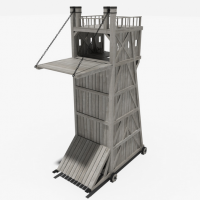








A siege tower is a specialized siege engine, constructed to protect assailants and ladders while approaching the defensive walls of a fortification. The tower was often rectangular with four wheels with its height roughly equal to that of the wall or sometimes higher to allow archers to stand on top of the tower and shoot into the fortification. Because the towers were wooden and thus flammable, they had to have some non-flammable covering of iron or fresh animal skins.
Early History
Used in ancient times, the siege tower was a four-sided, wheeled wooden tower designed as a siege engine to protect assailants when they were approaching the defensive walls of a fortress. Since the towers were wooden and thus flammable, they had to have some non-flammable covering of iron or fresh animal skins. Although they were mainly made from wood, sometimes they had metal parts. The tower had a square base and tapered towards the top. The siege tower moved on four wheels and had a height roughly equal to that of the wall, or sometimes higher to allow archers to stand on top of the tower and fire into the fortification.
Although the first known siege towers were used by the armies of the Asyrian Empire, they were extensively used by the Romans. With the collapse of the Roman Empire in the West into independent states, and the Eastern Roman Empire on the defensive, the use of siege towers reached its height during the medieval period. Siege towers also became more elaborate during the medieval period; at the Siege of Kenilworth Castle in 1266, for example, 200 archers and 11 catapults operated from a single tower. Even then, the siege lasted almost a year, making it the longest siege in English history.
Siege towers became vulnerable and obsolete with the development of large cannon. They had only ever existed to get assaulting troops over high walls and large cannon also made high walls obsolete as fortification took a new direction.
Later use
Siege towers also became more elaborate during the medieval period; at the Siege of Kenilworth Castle in 1266, for example, 200 archers and 11 catapults operated from a single tower.Even then, the siege lasted almost a year, making it the longest siege in English history. They were not invulnerable either, as during the Fall of Constantinople in 1453, Ottoman siege towers were sprayed by the defenders with Greek fire.
Siege towers became vulnerable and obsolete with the development of large cannon. They had only ever existed to get assaulting troops over high walls and large cannon also made high walls obsolete as fortification took a new direction. However, later constructions known as battery-towers took on a similar role in the gunpowder age; like siege-towers, these were built out of wood on site for mounting siege artillery. One of these was built by the Russian military engineer Ivan Vyrodkov during the siege of Kazan in 1552 (as part of the Russo-Kazan Wars), and could hold ten large-calibre cannon and 50 lighter cannons.Likely, it was a development of the gulyay-gorod (that is a mobile fortification assembled on wagons or sleds from prefabricated wall-sized shields with holes for cannons). Later battery towers were often used by the Ukrainian Cossacks.